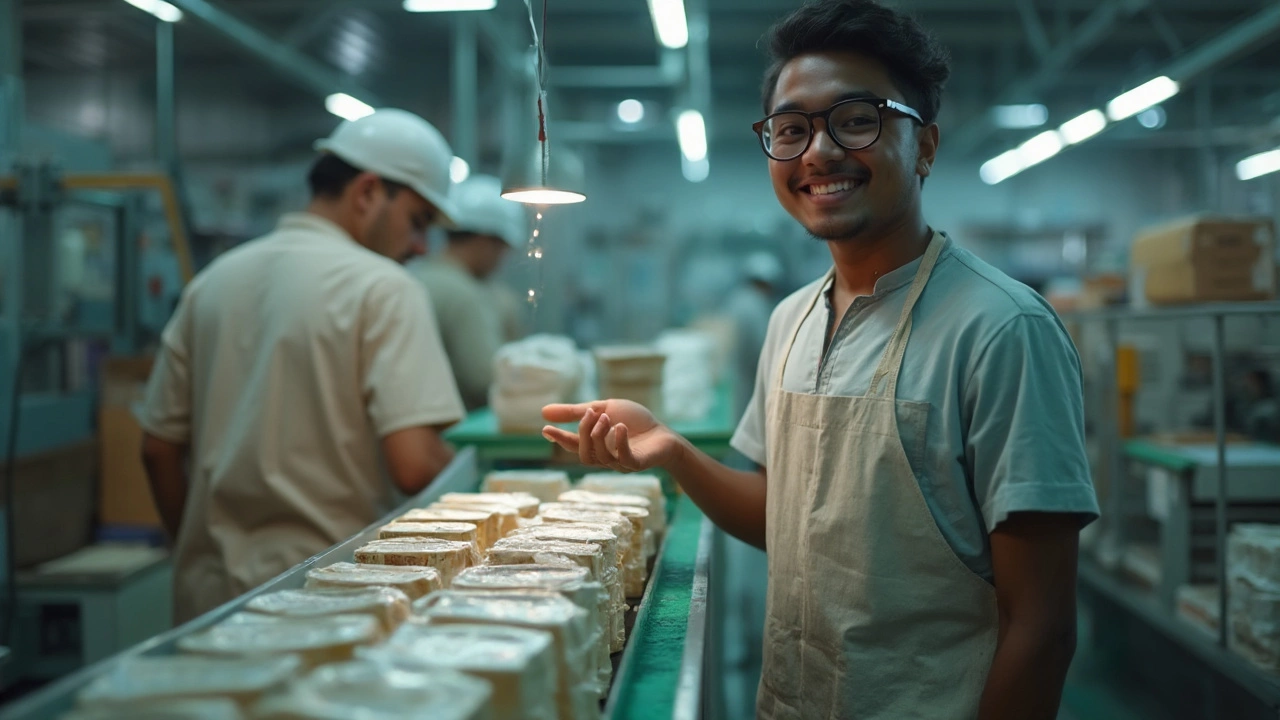Manufacturing might sound old school, but it’s seriously buzzing right now. Forget the days when you needed a massive factory and an army of workers just to get started. In 2025, even a small team can turn smart ideas into money makers thanks to new tech and changing customer habits. The trick is picking the right business, so you don’t sink your cash and energy into something that fizzles out fast.
Two manufacturing ideas stand head and shoulders above the rest: one rides the buzz of custom 3D printing, and the other taps the unstoppable demand for eco-friendly packaging. These aren't flashes in the pan. Both have real staying power, backed by big shifts in how people shop and what they care about. If you want a business that can start small, scale up, and survive changing trends, you’re in the right place.
- Why Manufacturing Still Pays
- First Top Business: 3D Printing Products
- Second Top Business: Eco-Friendly Packaging
- Real-World Tips to Get Started
Why Manufacturing Still Pays
People keep saying the economy is going digital, but here’s the thing—every shiny gadget, home appliance, and eco-friendly container still has to be made somewhere. Manufacturing isn’t just surviving in 2025; it’s kicking. Last year, the global manufacturing market was valued at $46 trillion, and it's only getting bigger with smarter tech and new consumer demands.
The real draw? Manufacturing can make you more than just quick cash. When you own a production process, you control quality, branding, and even your response to trends or shortages. Take the global chip shortage a few years back. Companies with their own production setups kept moving while others stalled waiting for suppliers. That edge is real.
The best part is, you don’t have to go huge right out of the gate. Automation, 3D printing, and remote tech can help small teams punch way above their weight. With the right idea and a tight process, smaller shops can fill gaps big businesses miss.
“Manufacturing keeps economies grounded. No matter how fast we move online, the need for real, physical products just keeps growing.” — World Economic Forum, Manufacturing Report 2024
Profit margins aren’t too shabby, either. Depending on the niche, small manufacturing businesses can hit margins of 10-20% or more, beating out lots of retail and service businesses. Plus, in hot areas like manufacturing business for sustainable packaging or custom printed products, you’re riding trends that show no signs of slowing down.
If you like having something to show for your work—something real that people actually use—manufacturing gives you that, plus the chance to build a brand that isn’t just another website lost on the internet.
First Top Business: 3D Printing Products
If you want a manufacturing business that moves fast and doesn’t need giant start-up costs, 3D printing is seriously hard to beat. You don’t need a big warehouse or factory—you can get started in a spare room or small workshop. The cool part? You can whip up custom parts, cool gadgets, or replacement pieces that regular folks and small companies can’t find anywhere else.
Here’s what makes 3D printing a top choice for a manufacturing business in 2025:
- Low barrier to entry: A basic desktop 3D printer now costs under $500. Even pro-level machines for small businesses rarely top $5,000.
- Personalization: Customers love custom stuff—phone cases, trophies, model parts, and home gadgets. You can design exactly what they want.
- Eco-friendlier: Less waste, less storage, and no need to ship products across the planet. You print on demand.
- Scalable: Start small and expand your lineup as orders grow.
The demand is real, too. Market research from 2024 showed the global 3D printing market growing at about 20% every year, with the biggest jumps in medical devices, automotive parts, and consumer gadgets. People will pay extra to get parts nobody else has or to fix broken stuff without tossing it in the trash.
| Year | 3D Printing Market Value (USD Billions) | Annual Growth (%) |
|---|---|---|
| 2022 | 16.7 | 17.7 |
| 2023 | 20.2 | 21.0 |
| 2024 | 24.2 | 19.8 |
Starting out? Here’s what you need to get rolling:
- Get a mid-range 3D printer—aim for reliability, not just low price.
- Learn basic 3D design with software like TinkerCAD or Fusion 360. There are tons of free online tutorials.
- Pick a niche—gadgets for gamers, model train parts, unique household holders, medical prototypes—whatever interests you and has active buyers out there.
- Set up an online shop on platforms like Etsy or Shopify, or approach small businesses that need custom parts on demand.
Here’s a pro tip: Don’t try to print everything. Pick a small group of products, make them really well, and build a rep for quality. Customers looking for unique or hard-to-find items will track you down if you stand out.

Second Top Business: Eco-Friendly Packaging
If you’re looking for a manufacturing business idea that’s not just smart but future-proof, eco-friendly packaging is tough to beat. Companies are dumping old plastic fast because customers and regulators are demanding greener stuff. Just look at Amazon switching to paper-padded mailers or Starbucks cutting single-use plastics. There’s a real scramble for alternatives—biodegradable bags, recycled cardboard, molded fiber trays, and compostable wraps.
Globally, the eco-packaging market is exploding. According to a 2024 report by Statista, the market is set to hit $413 billion by 2027. Europe and North America lead the charge, but even in Asia, big chains are getting rid of plastic. Food, cosmetics, and ecommerce need sustainable packaging more than ever. In fact, a recent Mintel survey found 52% of consumers say eco-packaging matters way more now than two years ago.
| Year | Global Eco-Packaging Market Value (USD) |
|---|---|
| 2023 | $320 billion |
| 2025 (projected) | $388 billion |
| 2027 (projected) | $413 billion |
What’s good about this business? You can start with small runs—think kraft-paper mailers, mushroom-based foam for electronics, or simple recycled boxes. Machines for basic biodegradable packaging don’t cost a fortune, and materials are getting cheaper as demand rises. There’s even grant money floating around for green startups if you dig a little.
Want to jump in? Here’s what can help you stand out:
- Partner with local businesses that want to ditch plastic.
- Start with one product—like compostable coffee cups or produce bags—then add more as you go.
- Make sure your packaging actually breaks down or recycles easily (people are watching for greenwashing now).
- Show off your certifications—think FSC, USDA Organic, or local compostable badges.
And don’t just sell to big brands. Local farmers, bakeries, and shops are hunting for sustainable options that don’t break the bank. Offer test samples or small runs so they can try before buying big.
Real-World Tips to Get Started
So you’re serious about jumping into the manufacturing business. Here’s the stuff you actually need to know to avoid expensive rookie mistakes—and get moving fast.
Don’t even think about renting out a huge industrial space at first. Start small and lean. Tons of successful 3D printing businesses began in a garage, and the first eco-packaging startups launched out of home kitchens. Only expand your space when sales actually force you to.
Here’s the stuff you should focus on right away:
- Market research: Get hyper-specific. If you’re going into 3D printing, don’t just Google it. Check what’s trending on Etsy, Amazon, and Reddit. For eco-packaging, look at local restaurants, cafes, and e-commerce shops. Ask what they hate about their current packaging.
- Pick your equipment wisely: It’s tempting to buy top-of-the-line gear, but many profitable founders started with entry-level or refurbished machines. Focus on reliability over flashy features—you just need solid output.
- Source smart: For both businesses, your raw materials can make or break your profit. Compare prices from local and overseas suppliers. Even a small difference can add up over hundreds of units monthly.
- Network with other makers: Join online forums, Facebook groups, and local meetups. Nothing beats learning from folks who’ve already done it—and most are happy to share what to avoid.
- Compliance and certifications: Eco-packaging especially needs to meet food safety standards in most regions. In the U.S., check FDA and ASTM standards. Not having the right paperwork can get you booted by big customers.
Here’s a snapshot of real costs and how long it might take to break even:
| Business Type | Startup Cost (USD) | Break-even Estimate |
|---|---|---|
| 3D Printing Products | $3,500 - $12,000 | 6-12 months |
| Eco-Friendly Packaging | $5,000 - $18,000 | 9-16 months |
Last but not least: Don’t get lost chasing every new idea you read online. Get a simple product out the door fast, fix what needs fixing, then ramp up. You’ll learn more from one customer order than a stack of business books.
